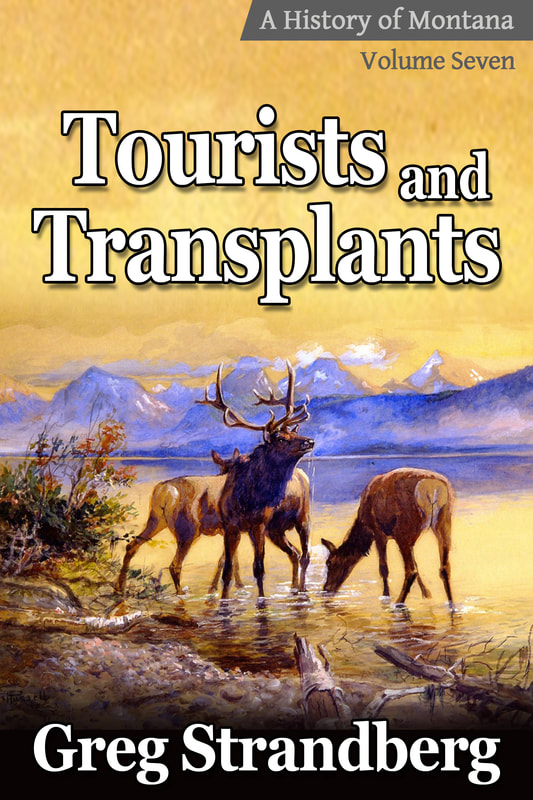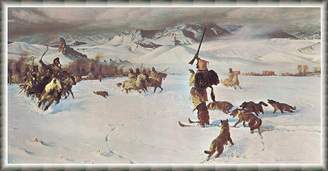 "John Colter Meets the Crow," John Clymer
"John Colter Meets the Crow," John Clymer
Montana in the early 19th century had the same scenery then as it does today, but it was a much more dangerous place, and fraught with perils. John Colter experienced these perils first-hand, and his tales are adventures are still spoken of today. Whether it was his amazing winter trek in 1807-8, or his daring escape from Blackfeet Indians three years later, Colter’s exploits have made him a legendary mountain man.
With Lewis and Clark
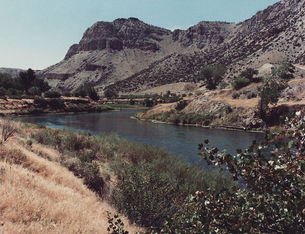 Wind River, upper reaches of Bighorn River
Wind River, upper reaches of Bighorn River
John Colter’s knowledge and expertise in everything outdoors proved invaluable to the expedition’s success, but he got a rocky start. After an argument at the party’s forward staging ground in Pittsburgh, Colter threatened to shoot John Ordway, a sergeant in the expedition. Colter nearly lost his place before the journey even started, but after he apologized and promised to do no wrong again, he was forgiven. And it was a good thing to; Colter’s hunting skills were unmatched on the expedition, and he was instrumental in finding Indians to show the way.
On the return trip in 1806, the party once again stopped at the Mandan Villages in North Dakota. They were met by two fur trappers heading up the Missouri, and Colter convinced Lewis and Clark to let him lead them up the river. It was agreed, and John Colter left the group two months early with an honorable discharge.
Finding Independence
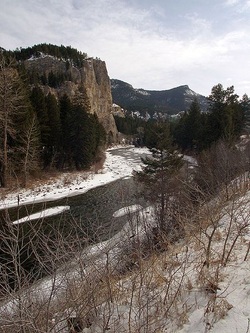 Winter on the Gallatin River
Winter on the Gallatin River
The order to talk with the Crow was given by Lisa, and he may have made a grave mistake. The territory the men were in was claimed by the Blackfeet, and Colter’s negotiations with the Crow, whom they considered their enemies, angered them. In fact, much of the Blackfeet’s enmity toward whites in Montana can be placed at Colter’s feet, and how they helped him both reach far-flung Indian tribes, and escape those that wanted to do him harm.
Colter journeyed extensively in the winter from October 1807 to around April 1808, and routinely did so in temperatures below freezing. The temperatures in January alone can get as low as -30 °F (-34 °C), and it’s a wonder he didn’t die from exposure. He travelled with only a gun, a pack weighing 30 pounds, and the clothes on his back. Perhaps it’s because he was always moving. He travelled hundreds of miles, perhaps as many as 500, through Montana and Wyoming, in areas that had never seen a white man before, and with no maps or guides to show him the way.
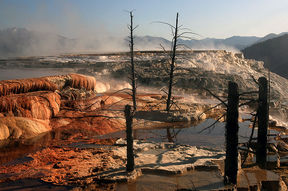 "Colter's Hell" (Mammoth Hot Springs)
"Colter's Hell" (Mammoth Hot Springs)
Upon his return, no one would believe his tall tales of geysers, alien landscapes, and amazing features. His companions laughed and joked about “Colter’s Hell, but other explorers would eventually stumble upon the same spectacular scenes. Colter’s trek through the wilderness covered much of what is today Yellowstone National Park and Grand Tetons National Park in Montana and Wyoming.
Indian Troubles
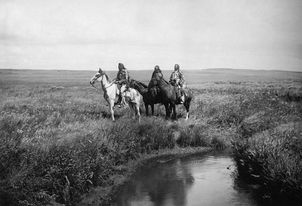 Blackfeet Indians, c. 1900
Blackfeet Indians, c. 1900
He teamed up with John Potts, a man he had travelled with during the Lewis and Clark Expedition. The plan was to head up the Missouri to Three Forks, and they were crossing the Bozeman Pass to get to the Gallatin River, when they ran into problems, many in fact.
While leading a group of Flathead Indians back to Fort Raymond to trade, the whole party was set upon by Blackfeet. The mixed group of Indians and whites were outnumbered, but saved when a band of Crow rode in. John Colter fought for his life, and was injured, taking a musket ball in the leg. The battle was still ranging around him, however, so he dragged himself into some nearby brush and continued the fight, firing on as many Blackfeet as he could until they finally ran off. Potts was also injured, and both men headed back to Fort Raymond to recuperate. The incident must have faded from their minds by that fall when the two again set out on the Missouri.
Colter's Run
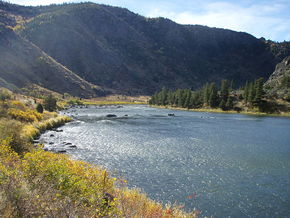 Madison River, near Ennis
Madison River, near Ennis
When he got there the Blackfeet grabbed him and stripped him naked. By that time Potts was adamant in his refusal to come ashore, and he took a bullet in the hip as a result. Angered, Potts raised his own gun and shot back, killing one Indian. The Blackfeet didn’t like that, and fired away until Potts was dead, at which point they dragged his body ashore and hacked it to pieces, even throwing some in Colter’s face.
Perhaps assuaged at their companion’s death by the death of Potts, the Indians decided not to kill Colter outright. Instead they decided to have some fun with him, and the leader of the group pointed east, said in Crow “go, go away,” and motioned for Colter to run. And run he did.
His goal was the Madison River, five miles away, and he possessed no shoes and not a stitch of clothing. It didn’t take long for the ground to take its toll. Pebbles and grass were the least of his worries, the prickly pear and larger rocks were the real danger. Not to mention the band of Blackfeet hot on his heels. His only consolation was that he wasn’t running up hill, but on a flat plain.
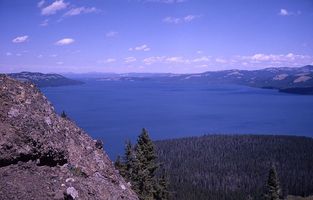 Yellowstone Lake
Yellowstone Lake
He retrieved the still-useable weapon, as well as the dead Indian’s blanket, and took off once again. He reached the Madison and jumped in, swam to the other side, and hid either beneath a flotilla of driftwood or a beaver lodge, his head barely above the water. The remaining Blackfeet searched for him all day, even sitting atop his hiding place at one point, but in the end they gave up and headed off, content at killing at least one white man that day.
A question arises as to whether John Colter took the shorter, easier route west over the Bozeman Pass and to the Yellowstone River, or the more grueling path to the southeast, a path that would take him up to 100 miles out of his way. Chances are he chose the latter. Not only did it take him out of Blackfeet country, something that he surely surmised was in his best interests at the time, but he knew the area well from his winter travels in 1807-8. And so he walked day and night, subsisting on roots and tree bark for the eleven days it took him to reach the fort.
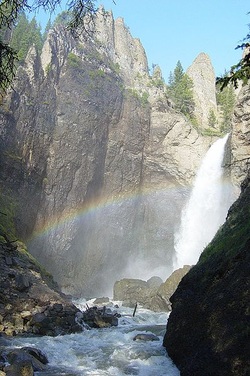 Colter most likely saw Tower Fall
Colter most likely saw Tower Fall
When the Blackfeet had told him to come ashore in the canoe on that eventful summer day on the Jefferson, Colter did so, but not before throwing his traps overboard. He didn’t want them to fall into the Indians’ hands then, and he meant to get them back now.
He headed over Bozeman Pass once again and reached the Gallatin River. He was settling down to a nice meal of boiled buffalo meat when he heard the tell-tale sound of twigs snapping. Instinct took over, honed from years in the Kentucky and Rocky Mountain wildernesses, and he dove down atop his fire. Musket balls flew over his head as he rolled into the black night. He immediately changed course and headed back to Fort Raymond, vowing to never return to the area again. And he didn’t, promising “God Almighty that he would never return to this area region again if he were only permitted to escape once more with his life.”
John Colter reached St. Louis by the winter of 1810, and he never returned to Montana. He married, and eventually met up with William Clark once again, detailing the areas he had explored during his winter sojourn of 1807-8. Clark used the information, together with that supplied by George Drouillard, to create the best map of the region up to that point, and for the next seventy-five years. John Colter died shortly thereafter, although sources conflict as to the exact date, either May 1812 or November 1813. He was just 38 years old.
A Final Run-in
Billington, Ray Allen; Ridge, Martin. Westward Expansion: A History of the American Frontier. No Publisher Listed, 2001. p 93-4.
Harris, Burton. John Colter: His Years in the Rockies. The University of Nebraska Press: Lincoln, 1993. p 35-40.
Malone, Michael Peter; Roeder, Richard B.; Lang, William L. Montana: A History of Two Centuries. The University of Washington Press, 1976. p 47-8.
Morris, Larry E. The Perilous West: Seven Amazing Explorers and the Founding of the Oregon Trail. Rowman & Littlefield Publishers, Inc: Plymouth, 2013. p 53-4.
Utley, Robert M. After Lewis and Clark: Mountain Men and the Paths to the Pacific. University of Nebraska Press: Lincoln, 1997. p 10-18.

